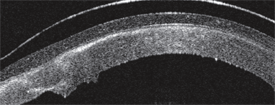 Question: I am just beginning to fit scleral lenses on difficult cases, such as keratoconus and grafts where corneal lenses don’t center well. Can you recommend a lens diameter as a starting point based on anatomical features or do you automatically start with a certain lens size?
Question: I am just beginning to fit scleral lenses on difficult cases, such as keratoconus and grafts where corneal lenses don’t center well. Can you recommend a lens diameter as a starting point based on anatomical features or do you automatically start with a certain lens size?
Answer: There is no “one size fits all” solution for scleral lenses. Each fitting must be handled on a case-by-case basis, taking every possible factor into account before selecting a lens diameter.
“In my opinion, one size never fits all, including fitting scleral lenses,” says Shelley Cutler, OD, who practices at Matossian Eye Associates in Doylestown, Pa. “I prefer to use smaller diameter mini-sclerals (15.0-18.0mm), if I can make the fit work. This does not always happen.”
Patients with keratoconus and other corneal irregularities pose a challenge to clinicians when fitting contact lenses. Special attention must be paid to a variety of patient-specific anatomical factors before settling on a lens. “I begin by looking at the lid anatomy. If the patient has small lid apertures, with tight lids, I know inserting a large scleral will be difficult,” explains Dr. Cutler. “If a patient has looser, flaccid lids which are easy to manipulate, inserting a larger lens will be less of an issue.”
 |
|
| OCT image of a scleral lens vaulting the corneal surface.
|
The severity of the corneal irregularity should also be considered when selecting a lens diameter. “Larger diameters are generally needed to successfully vault corneas as irregularity becomes more severe,” says Greg DeNaeyer, OD, clinical director of Arena Eye Surgeons in Columbus, Ohio. “This principle is based upon the fact that vault or sagittal depth of the lens increases with increasing diameter. Additionally, increasing diameter allows a broader area of landing to reduce compression or impingement. Use mini-scleral lenses (15.0-18.0mm) to manage mild/moderate irregularity and full scleral lenses (18.1-24.0+mm) to manage moderate/severe irregularity.
”A variety of factors can contribute to lens decentration, such as the lens size, incorrect corneal vault or the constant, everyday movement of the eye by the patient.
“Scleral lenses can decenter slightly down and out on the eye (1-2mm) and this is more commonly seen with large scleral lenses,” says Dr. DeNaeyer. Issues with decentration inferiorly can arise with keratoconus patients, especially if the patient has tight lids. “The lens will position over the steepest part of the cornea,” Dr. Cutler says. “In the area of the highest corneal elevation (as noted by topographical data), lack of clearance becomes evident. This can create pathology over time.”
“Decentration, in my experience, is more common when there is more corneal vault than needed, as the lens is pushed down by the upper lid,” says Dr. Jedlicka. “Decentration can be addressed by decreasing the corneal vault if the fit allows it, going to a slightly smaller diameter if that is possible or by considering toric scleral curves to better align the lens to the scleral shape.”

